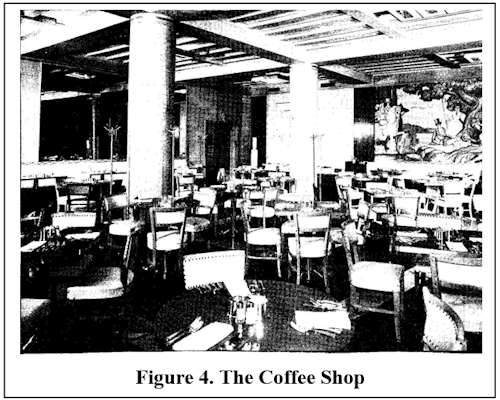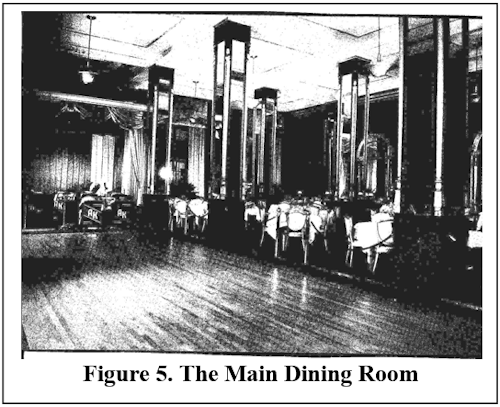From 1935 until 1945, my family lived in
the management suite at The Robert Treat Hotel in Newark, New Jersey.
The Robert Treat had fourteen floors, ten dedicated to guest-rooms.
On the first two floors was a large front lobby with high ornate
ceiling, marble floors and Greek columns. Figure 1 shows what the
lobby looked like when we moved to Newark in the summer of 1935.
i

An article in a 1938 issue of Hotelier and Restaurateur magazine
describes the lobby in these words : “Originally designed
in the Renaissance Revival style, the lobby was furnished with high-backed
Victorian chairs, upholstered with dark fabric and ornately carved
armrests. Among the most formal features of the original lobby were
its fluted Ionic columns, topped with ornate scrolls above the shaft.
A seasoned traveler could’t help being reminded of the Temple
of Athena in Athens, Greece.” ii
Guests would enter the front entrance of the hotel from Park Street
through a revolving door and climb the steps up to the main lobby.
If they wanted to get a room, they would go to the reservation desk
(on the left in the picture). If they already had a room, they would
walk straight ahead toward the two guest elevators under the mezzanine,
a kind of balcony that overlooked the lobby.
On the south wall of the lobby was a large painting showing a
Lenni-Lenape Indian chief bartering with a man dressed like a Pilgrim.
My parents told me this was Robert Treat, the man who bought Newark
in 1666 with “a few bags of beads and baubles.” Historical
documents reveal that the cost was in fact approximately $700, which
is still a bargain for an area of land that makes up Essex County.
(Figure 2) iii

Sometimes visitors would come into the lobby just to sit and wait
for someone or to buy cigarettes or chewing gum at the concession
stand, which was located to the right of the entrance. The lobby
was a busy place because there was always something going on at
the hotel, whether it was a big convention in the ball room on the
mezzanine floor or a wedding party in the main dining room, which
was on the same floor as the lobby. Bellhops were constantly scurrying
everywhere, carrying suitcases or paging people. There were always
at least two bellhops on duty in the lobby, no matter what time
of day or night. Like the desk clerks and elevator operators, they
worked in shifts.
One of the most famous bellhops of all time once visited The Robert
Treat while my family lived there. His name was Johnny Roventini
of the Hotel New Yorker. Johnny’s smiling face appeared in
magazines and on billboards all across America during the 1940s
and 1950s and his squeaky voice was heard on nationwide radio broadcasts
as he cried out, “Call for Phillip Mor-reees!” My parents
actually induced Johnny to sign a souvenir postcard for me. (Figure
3) iv

My father, Lloyd G. Robinson, was the manager of The Robert Treat
Hotel, so everybody else who worked there treated our family like
royalty. There were more than 100 full-time employees at the Robert
Treat, including doormen and bellhops, waiters and waitresses, elevator
operators and maids, bakers and cooks, bookkeepers and secretaries,
tailors and laundresses, carpenters and engineers, janitors and
valets, desk clerks and cashiers. The list goes on and on.
The people who worked at The Robert Treat liked my father because
he was always jolly and friendly. During the first few weeks on
the job, my father made a point of learning everybody’s first
name — whether it was the night watchman or the assistant
manager. As the General Manager, my father probably worked longer
hours than any other employee at the hotel. He was up, showered,
dressed and out the door for work every morning at 7:00. Because
he was constantly on the move, we rarely saw him again until dinner
time at 6:30 p.m.
Most of all, my father’s co-workers liked him because he
treated everyone as an equal and had a generous spirit. Every Christmas,
he threw a big party in the hotel ballroom for all the employees’
children. Santa Claus came, and every child received a Christmas
gift.
My mother, father, older sister (Rowena) and I lived in a beautiful
corner suite on the 9th floor of the Robert Treat (Room number 912).
If you look at the picture of The Robert Treat Hotel on) the Robert
Treat Center website, you’ll see a row of balconies across
the front of the building. v
These balconies were on the ninth floor, and the two on the far
right were under the windows of our living room. The suite included
a large living room with windows looking out over Military Park,
a front foyer leading into the living room on the right and my parents’
master bedroom on the left. Connected to my parents’ bedroom
was a second bedroom I shared with my sister.
Usually, my family ate our meals downstairs in the Coffee Shop,
which was on the ground floor below the main lobby. The Coffee Shop
had a big mural showing men in top hats and boots and women with
long flowing gowns enjoying a picnic in the days when people went
on fox hunts in Essex County. (Figure 4)

On special occasions, we ate dinner in the Main Dining Room, which
was on the same floor as the lobby. This was a very fancy restaurant,
with a high ceiling, mirrored columns and a large dance floor with
a band stand. Whenever we went there for dinner, the maitre d’
— a very distinguished looking gentleman named Werner Freymuth
—would bow to my mother and father and say polite things like,
“Good evening, Mr. and Mrs. Robinson. Would you care for canapé?”
(Figure 5)

Sometimes we would order room service. That was usually when my
parents had to attend a banquet dinner or my sister and I didn’t
feel well enough to go to the Coffee Shop or the Main Dining Room.
I especially remember the bald-headed man who used to bring our
meals up on a cart. I think his name was Gus. He was always very
kind and courteous, although there was one time when he dropped
the rolls off his cart in the hallway and I heard him say a bad
word. I didn’t tell my parents about this, though, because
I didn’t want Gus to get into trouble.
The best part about living at The Robert Treat was that you could
order just about anything you wanted to eat at any meal. The hotel
menu offered a wide range of choices. There were appetizers like
fruit cup and shrimp cocktail; soups like tomato bisque and onion
with cheese; main courses like thick slices of roast beef or turkey
with gravy, or lamb chops served with funny-looking little paper
chef’s hats. Then, of course, there were always different
choices for dessert, including pies and cakes made daily in the
hotel bakery.
Often, my father would give me the cherry in the bourbon old-fashion
cocktail he had every night before dinner. I didn’t know it
when I was a child, but years later I would learn that, within a
few minutes, a cherry will absorb most of the alcohol in a mixed
drink. Apparently, my parents didn’t know that either.
During the first few months while we lived at The Robert Treat,
there were many things my mother, my sister and I didn’t know.
We didn’t know, for instance, that Newark - like many cities
- was suffering from the worst economic depression in our nation’s
history and that poverty and crime were rampant everywhere. Though
our family seemed to be living in the lap of luxury, one quarter
of America’s workforce (14 million people) were unemployed
in 1935vi. We also didn’t know that one of
the most notorious gangsters in America, Dutch Schultz, had recently
moved his gang into the Robert Treat Hotel, occupying the entire
tenth floor.
Although Prohibition had ended in December of 1933, syndicated
crime was still a nation-wide problem. The production and sale of
bootlegged liquor was only one part of the illicit activities that
generated revenue for the crime syndicates, including everything
from the numbers racket to narcotics sales and prostitution. In
July of 1935, at just about the time when my father became General
Manager of the Robert Treat, the State of New York appointed Thomas
E. Dewey as a special prosecutor to lead the attack on organized
crime. It was his aggressive investigations, in fact, that had forced
Dutch Schultz to move his operations out of New York City across
the Hudson River to New Jersey.
© Bruce Robinson
______________________________________________________________
i: http://newarkbusiness.org/photos/service/displayimage.php?pid=27
ii: “A Fine Hotel” in Restaurateur and Hotelier magazine.
iii: https://www.flickr.com/photos/sweintraub/308332206/in/photostream/
iv: Figures 3, 4, and 5 are from the private archives of Bruce
Robinson.
v: http://www.bergerorg.com/roberttreatcenter.htm
vi: Amity Shlaes, The Forgotten Man (New York, 2007) page214.
|

